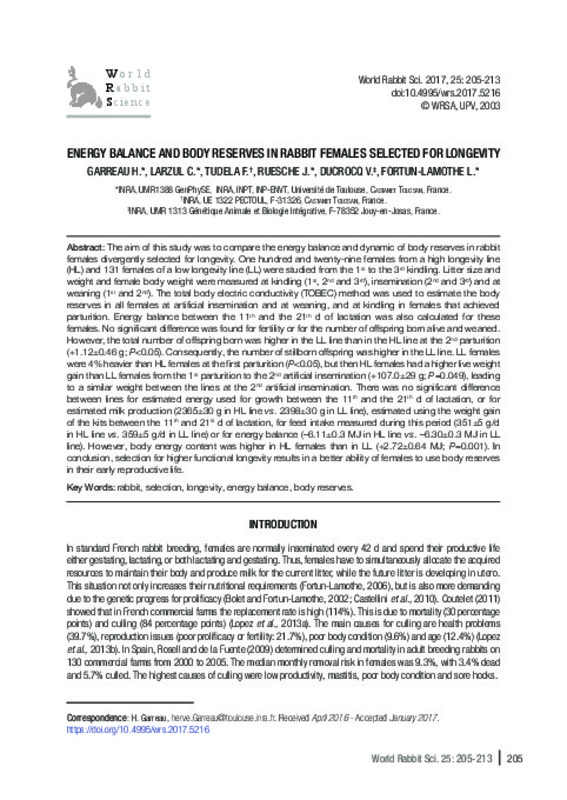JavaScript is disabled for your browser. Some features of this site may not work without it.
Buscar en RiuNet
Listar
Mi cuenta
Estadísticas
Ayuda RiuNet
Admin. UPV
Energy balance and body reserves in rabbit females selected for longevity
Mostrar el registro sencillo del ítem
Ficheros en el ítem
| dc.contributor.author | Garreau, H.
|
es_ES |
| dc.contributor.author | Larzul, C.
|
es_ES |
| dc.contributor.author | Tudela, F.
|
es_ES |
| dc.contributor.author | Ruesche, J.
|
es_ES |
| dc.contributor.author | Ducrocq, V.
|
es_ES |
| dc.contributor.author | Fortun-Lamothe, L.
|
es_ES |
| dc.date.accessioned | 2017-09-29T07:07:03Z | |
| dc.date.available | 2017-09-29T07:07:03Z | |
| dc.date.issued | 2017-09-28 | |
| dc.identifier.issn | 1257-5011 | |
| dc.identifier.uri | http://hdl.handle.net/10251/88220 | |
| dc.description.abstract | [EN] The aim of this study was to compare the energy balance and dynamic of body reserves in rabbit females divergently selected for longevity. One hundred and twenty-nine females from a high longevity line (HL) and 131 females of a low longevity line (LL) were studied from the 1st to the 3rd kindling. Litter size and weight and female body weight were measured at kindling (1st, 2nd and 3rd), insemination (2nd and 3rd) and at weaning (1st and 2nd). The total body electric conductivity (TOBEC) method was used to estimate the body reserves in all females at artificial insemination and at weaning, and at kindling in females that achieved parturition. Energy balance between the 11th and the 21th d of lactation was also calculated for these females. No significant difference was found for fertility or for the number of offspring born alive and weaned. However, the total number of offspring born was higher in the LL line than in the HL line at the 2nd parturition (+1.12±0.46 g; P<0.05). Consequently, the number of stillborn offspring was higher in the LL line. LL females were 4% heavier than HL females at the first parturition (P<0.05), but then HL females had a higher live weight gain than LL females from the 1st parturition to the 2nd artificial insemination (+107.0±29 g; P=0.049), leading to a similar weight between the lines at the 2nd artificial insemination. There was no significant difference between lines for estimated energy used for growth between the 11th and the 21th d of lactation, or for estimated milk production (2365±30 g in HL line vs. 2398±30 g in LL line), estimated using the weight gain of the kits between the 11th and 21st d of lactation, for feed intake measured during this period (351±5 g/d in HL line vs. 359±5 g/d in LL line) or for energy balance (–6.11±0.3 MJ in HL line vs. –6.30±0.3 MJ in LL line). However, body energy content was higher in HL females than in LL (+2.72±0.64 MJ; P=0.001). In conclusion, selection for higher functional longevity results in a better ability of females to use body reserves in their early reproductive life. | es_ES |
| dc.language | Inglés | es_ES |
| dc.publisher | Universitat Politècnica de València | |
| dc.relation.ispartof | World Rabbit Science | |
| dc.rights | Reserva de todos los derechos | es_ES |
| dc.subject | Rabbit | es_ES |
| dc.subject | Selection | es_ES |
| dc.subject | Longevity | es_ES |
| dc.subject | Energy balance | es_ES |
| dc.subject | Body reserves | es_ES |
| dc.title | Energy balance and body reserves in rabbit females selected for longevity | es_ES |
| dc.type | Artículo | es_ES |
| dc.date.updated | 2017-09-29T06:59:45Z | |
| dc.identifier.doi | 10.4995/wrs.2017.5216 | |
| dc.rights.accessRights | Abierto | es_ES |
| dc.description.bibliographicCitation | Garreau, H.; Larzul, C.; Tudela, F.; Ruesche, J.; Ducrocq, V.; Fortun-Lamothe, L. (2017). Energy balance and body reserves in rabbit females selected for longevity. World Rabbit Science. 25(3):205-213. https://doi.org/10.4995/wrs.2017.5216 | es_ES |
| dc.description.accrualMethod | SWORD | es_ES |
| dc.relation.publisherversion | https://doi.org/10.4995/wrs.2017.5216 | es_ES |
| dc.description.upvformatpinicio | 205 | es_ES |
| dc.description.upvformatpfin | 213 | es_ES |
| dc.type.version | info:eu-repo/semantics/publishedVersion | es_ES |
| dc.description.volume | 25 | |
| dc.description.issue | 3 | |
| dc.identifier.eissn | 1989-8886 |








